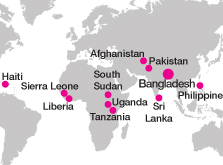Beauty of alternative learning: Getting students to schools
UNESCO Bangkok article by Kanit Teerathumaskul and Rojana Manowalailao
28 November 2012
In the marshlands of Bangladesh where the combination of floods and poverty make normal schooling almost impossible, BRAC’s ‘floating schools’ serve a dual purpose. They act as a bus to pick up children and as a classroom for learning. The new initiative of BRAC to build 400 boats for children from disadvantaged backgrounds living in the flood plains of remote parts of Bangladesh is among many other alternative learning strategies that this largest development organisation in the world has introduced.
 Profulla Chandra Barman, Programme Coordinator of the BRAC primary school, visited Thailand to attend a Regional Meeting on Alternative Learning/Schooling Programmes for Primary Education to Reach the Unreached organized by UNESCO Bangkok in early November to present the BRAC model, share experiences and discuss innovative ways to get out-of-school children to learn and graduate.
Profulla Chandra Barman, Programme Coordinator of the BRAC primary school, visited Thailand to attend a Regional Meeting on Alternative Learning/Schooling Programmes for Primary Education to Reach the Unreached organized by UNESCO Bangkok in early November to present the BRAC model, share experiences and discuss innovative ways to get out-of-school children to learn and graduate.
BRAC’s specific approach to alternative learning has been followed by over 400 local NGOs in Bangladesh. Starting as relief operation in 1972 in a remote village of Bangladesh, the organization has spread to 10 other countries around the world. It has supported and facilitated the alternative schooling approach in Pakistan, Philippines, Uganda, and Liberia, using a holistic development model towards inclusion and tools like microfinance, education, healthcare, legal services, and community empowerment.
BRAC provides a five-year primary education course to the poor and disadvantaged children and to drop-outs that cannot access formal schooling. It has touched the lives of an estimated 126 million across the globe.
“Children are the main part of this school,” said Mr. Barman. “Our teaching and learning process is designed in that way with the children centered approach.”
The organization emphasizes on the curriculum framework by considering students as the center of attention. This can be easily seen by their classroom settings. The classroom desks are set in a V-shape to enable teachers to give equal attention to all students.
With the student centered approach, new methods to help children learn more easily have been developed. At BRAC, learning can be done through many unique ways.
Learning through group or peer discussions are one of the main keys. Students are introduced to a discussion topic related to their lives, such as ‘how neighbours help each other’. The teacher first gives a background about the topic before introducing the question to the students. Then students ask each other questions, share ideas and give opinions. The group discussions allow students to interact and leads to an effective learning process.
“The learning process happens not only by the teacher but it happens also by the peer discussions,” said Mr. Barman.
“In most education systems, teachers tend to make more complications to the learners. They hassle themselves by not engaging the students in learning,” he said.
Twenty-seven million primary school-aged children in Asia and the Pacific do not go to school. According to UNESCO, 40 per cent of out-of-school children in South and West Asia have previously been in school. The challenge of out-of-school children is a complex combination of deep-rooted inequalities associated to gender, ethnicity, wealth and location, in addition to poor quality of education.
Although an enrolment rate in many countries in the region has been improving, progress has been slow as a number of children drop out before completing the full primary school cycle. Alternative learning and schooling programmes are indispensable and need support by legitimate education policies and frameworks.
Mr. Barman said: “The UN organization UNESCO can be more proactive to incorporate this plan within the government system because it can impose every government to incorporate it into the education plan in each country.”
This article wa originally posted here: http://www.unescobkk.org/news/article/beauty-of-alternative-learning-getting-students-to-schools/







Connect With Us